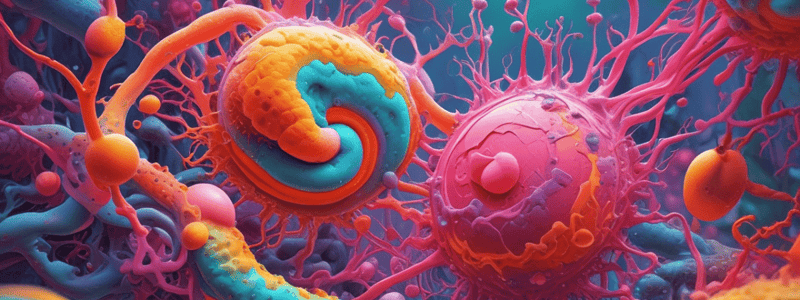Podcast
Questions and Answers
What is the main purpose of homeostasis in living systems?
What is the main purpose of homeostasis in living systems?
- To induce shivering and sweating simultaneously
- To maintain optimal conditions despite a changing environment (correct)
- To completely shut down bodily functions
- To increase the body temperature above normal levels
How is homeostasis maintained in cells?
How is homeostasis maintained in cells?
- By ignoring changes in the environment
- Through positive feedback loops
- Via negative feedback loops (correct)
- By allowing internal conditions to fluctuate freely
What happens when the body temperature of a human rises above 98.6 degrees Fahrenheit?
What happens when the body temperature of a human rises above 98.6 degrees Fahrenheit?
- The body starts to shiver to generate more heat
- Blood vessels constrict to reduce heat loss
- Sweating and blood vessel dilation occur (correct)
- Insulin is released by the pancreas
Which example illustrates a negative feedback loop?
Which example illustrates a negative feedback loop?
Why is glucose homeostasis important for animals?
Why is glucose homeostasis important for animals?
What role does insulin play in glucose homeostasis?
What role does insulin play in glucose homeostasis?
How do negative feedback loops help maintain homeostasis in living systems?
How do negative feedback loops help maintain homeostasis in living systems?
What is the primary function of insulin in regulating blood glucose levels?
What is the primary function of insulin in regulating blood glucose levels?
When blood glucose levels drop too low, which hormone is released by the pancreas?
When blood glucose levels drop too low, which hormone is released by the pancreas?
What is the primary role of the cell membrane in maintaining homeostasis?
What is the primary role of the cell membrane in maintaining homeostasis?
What is the structure of the cell membrane?
What is the structure of the cell membrane?
How does the presence of cholesterol in the cell membrane contribute to homeostasis?
How does the presence of cholesterol in the cell membrane contribute to homeostasis?
What is the process by which water moves across the cell membrane?
What is the process by which water moves across the cell membrane?
What is the role of aquaporins in maintaining homeostasis?
What is the role of aquaporins in maintaining homeostasis?
How does the cell maintain an electrochemical gradient across the membrane?
How does the cell maintain an electrochemical gradient across the membrane?
Flashcards are hidden until you start studying
Study Notes
Homeostasis in Cells
- Homeostasis is the set of internal conditions maintained by living systems to function optimally, despite changing environmental conditions.
- All cells must maintain homeostasis to stay alive.
- Homeostasis is maintained through negative feedback loops, where the product of a pathway shuts it off.
Regulation of Body Temperature
- The optimal body temperature for humans is 98.6 degrees Fahrenheit.
- Mechanisms to cool down include sweating and blood vessels moving towards the surface in extremities to release heat.
- When the body temperature cools down, mechanisms like shivering or constriction of blood vessels kick in to maintain homeostasis.
Glucose Homeostasis
- Glucose homeostasis is maintained through a negative feedback loop involving insulin and glucagon hormones.
- When blood glucose levels rise after food ingestion, insulin is released, allowing cells to take up glucose from the blood.
- When blood glucose levels drop too low, glucagon is released, causing muscle and liver cells to release glucose into the blood.
The Cell Membrane and Homeostasis
- The cell membrane is the main organelle responsible for maintaining homeostasis in cells.
- The cell membrane is composed of a phospholipid bilayer with hydrophilic heads and hydrophobic tails.
- Cholesterol in the membrane and short tails keep the membrane fluid, allowing for material transport.
- Proteins in the membrane help move large or charged molecules across the membrane.
Osmosis and Water Regulation
- Osmosis is the process of water moving from high to low concentration, or from low to high solute concentration.
- Water flows through the membrane directly or through aquaporin protein channels, regulating water movement into and out of the cell.
Ion Flow Regulation
- The cell membrane controls ion flow to maintain optimal levels necessary for cellular function.
- The cell maintains high potassium ion concentrations inside and high sodium ion concentrations outside, creating an electrochemical gradient.
- Active transport is used to pump sodium ions out and potassium ions in, maintaining the gradient.
Studying That Suits You
Use AI to generate personalized quizzes and flashcards to suit your learning preferences.




